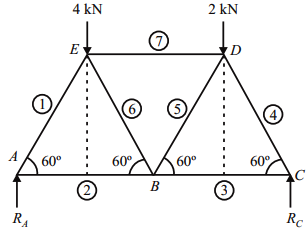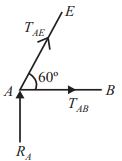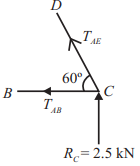The reaction at the hinged support (end A) can have two components acting in the horizontal and vertical directions. Since the applied loads are vertical, the horizontal component of reaction at A is zero and there will be only vertical reaction RA, Roller support (end C) is frictionless and provides a reaction RC at right angles to the roller base. Let the forces in the entire member is tensile. First calculate the distance of different loads from point A.
Distance of Line of action of 4KN,
from point A = AF = AE cos 60 = 2X 0.5 = 1m
Distance of Line of action of 2KN,
from point A = AG = AB + BG = AB + BD cos 60
= 2 + 2 x 0.5 = 3m
Taking moment about point A,
RC X 4 – 2 x 3 + 4 x 1 = 0RC = 2.5KN ...(i)
RA = 4 + 2 – 2.5 = 3.5 KN ...(ii)

Joint A:
Consider FBD of A as shown in fig. Let, TAE = Force in the member AETAB = Force in the member AB Direction of both the forces (TAE & TAB) is taken away from point A. Since three forces are acting at A. So apply lami’* theorem at B.TAE/sin270 = TAB/sin30 = RA/sin60 TAE/sin 270 = TAB/sin30 = 3.5/sin60.

On solving
TAE = – 4.04KN ...(iii)
TAE = 4.04KN (Compressive)
TAB = 2.02KN ...(iv)
TAB = 2.02KN (Tensile
Joint B:
Consider FBD of C as shown in fig, Let, TBC = Force in the member BCTDC = Force in the member DC Direction of both the forces(TBC & TDC) is taken away from point C. Since three forces are acting at C. So apply lami’* theorem at C.TBC/sin30 = TDC/sin 270 = RC/sin 60 TBC/sin30 = TDC/sin 270 = 2.5/sin 60 On solving.
TBC = 1.44KN ...(v)
TBC = 1.44KN (Tensile)
TDC = -2.88KN ...(iv)
TDC = 2.88KN (Compressive)

Joint c:
Consider FBD of B as shown in fig. Since, TAB = 2.02KN(T) TBC = 1.44KN(T) Let,TBE = Force in the member BETDB = Force in the member DB Direction of both the forces (TBE & TDB) is taken away from point B. Since four forces are acting at B. So apply resolution of forces as equilibrium at B.
RH = 0
– TAB + TBC –TBE cos 60 + TBD cos 60 = 0
– 2.02 + 1.44 – 0.5TBE + 0.5TBD = 0
TBE – TBD = 1.16 ...(vii)
RV = 0
TBE sin 60 + TBD sin 60 = 0
TBE = – TBD ...(viii)
Value of equation (viii) put in equation (vii), we get i.e
–2 TBE = 1.16, or
TBE = -0.58KN ...(ix)
TBE = 0.58KN (Compression
TBD = 0.58KN (Tensile)

Joint D:
Consider FBD of D as shown in fig 13.13 Since, TCD = -2.88KN(C) TBD = 0.58KN(T) Let,TED = Force in the member ED Direction of forces TCD, TBD & TED is taken away from point D. Since four forces are acting at D. So apply resolution of forces as equilibrium at D.
RH = 0
– TED – TBD cos 60 + TCD cos 60 = 0
– TED – 0.58 X 0.5 + (-2.88) X 0.5 = 0
TED = – 1.73KN.

| Member | Force | Member | Force |
| AE | 4.04KN(C) | BE | 0.58KN(C) |
| AB | 2.02KN(T | BD | 0.58KN(T) |
| BC | 1.44KN(T) | DE | 1.73KN(C) |
| CD | 2.88KN(C) | | |